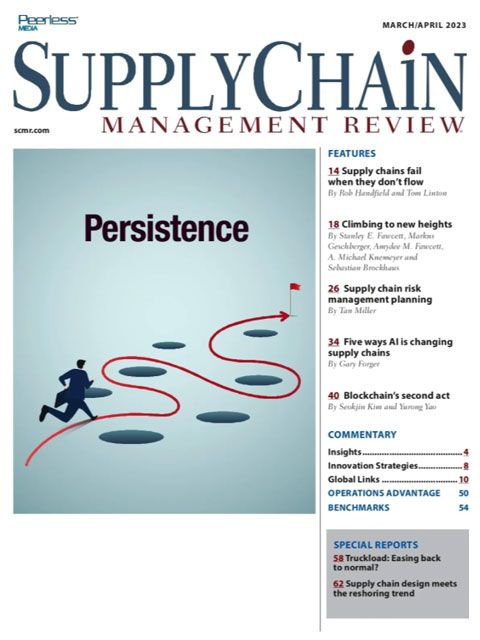Sorry, but your login has failed. Please recheck your login information and resubmit. If your subscription has expired, renew here.
March-April 2023
In June 2013, Frank Quinn stepped down as the only editorial director Supply Chain Management Review had ever known. “In thinking about those whom I’m indebted to for the success of SCMR over 16 years, there is one constituency that must rank first on the list—you, the reader,” Frank wrote, as he handed over the reins to Bob Trebilcock. Now, Bob has done the same, handing over the reins to the next generation. I am very proud to be that next generation. In a farewell letter of sorts, Bob wrote that he was the “old” and I as the “new.” Nothing could be further from the truth. There is no old or new, only continuity. That continuity is… Browse this issue archive.Need Help? Contact customer service 847-559-7581 More options
Many companies rely on an iterative, continuous improvement approach to improve their supply chain operations, capturing 2% to 3% of year-on-year cost improvements. The best operators can achieve 3% to 5% and deploy corrections that prevent future challenges. While these efforts may help mitigate inflation or solve immediate service and quality challenges, they may not be enough to help ambitious companies achieve their goals. And such cases demand a comprehensive transformation strategy that goes beyond single-digit savings.
There are many reasons to pursue a supply chain transformation. For example, a business integration after an acquisition may lead to reorganizing an entire operation. Or changes in leadership create an opportunity to execute a transformation; a shift in supply chain operations may help new leaders execute their strategic visions. Other times, the forces are external—impending macroeconomic pressures or supply chain performance issues create a need to transform. As costs balloon from inflation or liquidity becomes scarce, a radical cost transformation may be the answer.
Over the past decade, we have had the opportunity to help several clients with significant supply chain transformations, projects at top companies that yielded billions of dollars in savings. In this article, we would like to share key best practices, lessons learned, and a proven transformation approach based on our collective experience.

This complete article is available to subscribers only.
Log in now for full access or start your PLUS+ subscription for instant access.
SC
MR
Sorry, but your login has failed. Please recheck your login information and resubmit. If your subscription has expired, renew here.
March-April 2023
In June 2013, Frank Quinn stepped down as the only editorial director Supply Chain Management Review had ever known. “In thinking about those whom I’m indebted to for the success of SCMR over 16 years, there is… Browse this issue archive. Access your online digital edition. Download a PDF file of the March-April 2023 issue.Many companies rely on an iterative, continuous improvement approach to improve their supply chain operations, capturing 2% to 3% of year-on-year cost improvements. The best operators can achieve 3% to 5% and deploy corrections that prevent future challenges. While these efforts may help mitigate inflation or solve immediate service and quality challenges, they may not be enough to help ambitious companies achieve their goals. And such cases demand a comprehensive transformation strategy that goes beyond single-digit savings.
There are many reasons to pursue a supply chain transformation. For example, a business integration after an acquisition may lead to reorganizing an entire operation. Or changes in leadership create an opportunity to execute a transformation; a shift in supply chain operations may help new leaders execute their strategic visions. Other times, the forces are external—impending macroeconomic pressures or supply chain performance issues create a need to transform. As costs balloon from inflation or liquidity becomes scarce, a radical cost transformation may be the answer.
Over the past decade, we have had the opportunity to help several clients with significant supply chain transformations, projects at top companies that yielded billions of dollars in savings. In this article, we would like to share key best practices, lessons learned, and a proven transformation approach based on our collective experience.
SC
MR


Latest Supply Chain News
- Joseph Esteves named CEO of SGS Maine Pointe
- Employees, employers hold divergent views on upskilling the workforce
- April manufacturing output slides after growing in March
- Q1 sees a solid finish with positive U.S.-bound import growth, notes S&P Global Market Intelligence
- World Trade Centers offers a helping hand to create resilient, interconnected supply chains
- More News
Latest Podcast

 Explore
Explore
Procurement & Sourcing News
- April manufacturing output slides after growing in March
- World Trade Centers offers a helping hand to create resilient, interconnected supply chains
- Bridging the ESG gap in supply chain management: From ambition to action
- Israel, Ukraine aid package to increase pressure on aerospace and defense supply chains
- How CPG brands can deliver on supplier diversity promises
- How S&OP provides the answer to in-demand products
- More Procurement & Sourcing
Latest Procurement & Sourcing Resources

Subscribe

Supply Chain Management Review delivers the best industry content.

Editors’ Picks






